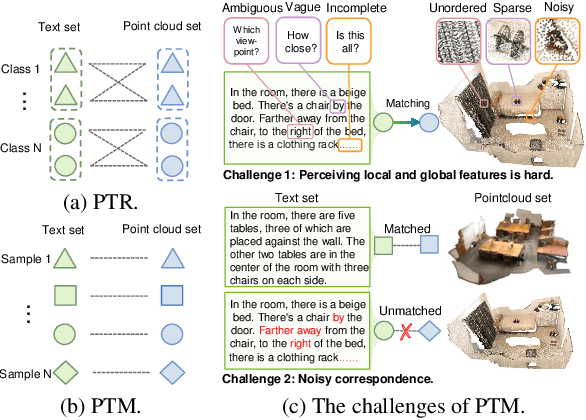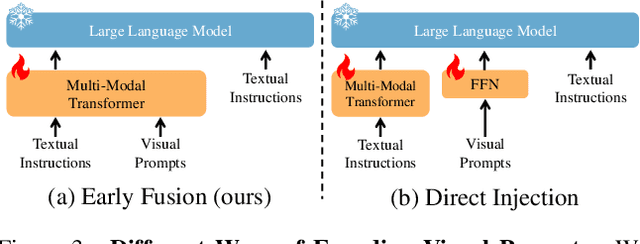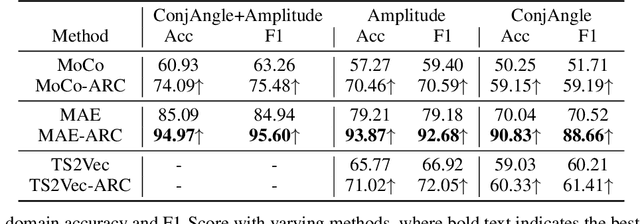Hongyuan Zhu
Object-level Correlation for Few-Shot Segmentation
Sep 09, 2025Abstract:Few-shot semantic segmentation (FSS) aims to segment objects of novel categories in the query images given only a few annotated support samples. Existing methods primarily build the image-level correlation between the support target object and the entire query image. However, this correlation contains the hard pixel noise, \textit{i.e.}, irrelevant background objects, that is intractable to trace and suppress, leading to the overfitting of the background. To address the limitation of this correlation, we imitate the biological vision process to identify novel objects in the object-level information. Target identification in the general objects is more valid than in the entire image, especially in the low-data regime. Inspired by this, we design an Object-level Correlation Network (OCNet) by establishing the object-level correlation between the support target object and query general objects, which is mainly composed of the General Object Mining Module (GOMM) and Correlation Construction Module (CCM). Specifically, GOMM constructs the query general object feature by learning saliency and high-level similarity cues, where the general objects include the irrelevant background objects and the target foreground object. Then, CCM establishes the object-level correlation by allocating the target prototypes to match the general object feature. The generated object-level correlation can mine the query target feature and suppress the hard pixel noise for the final prediction. Extensive experiments on PASCAL-${5}^{i}$ and COCO-${20}^{i}$ show that our model achieves the state-of-the-art performance.
Ego-R1: Chain-of-Tool-Thought for Ultra-Long Egocentric Video Reasoning
Jun 16, 2025Abstract:We introduce Ego-R1, a novel framework for reasoning over ultra-long (i.e., in days and weeks) egocentric videos, which leverages a structured Chain-of-Tool-Thought (CoTT) process, orchestrated by an Ego-R1 Agent trained via reinforcement learning (RL). Inspired by human problem-solving strategies, CoTT decomposes complex reasoning into modular steps, with the RL agent invoking specific tools, one per step, to iteratively and collaboratively answer sub-questions tackling such tasks as temporal retrieval and multi-modal understanding. We design a two-stage training paradigm involving supervised finetuning (SFT) of a pretrained language model using CoTT data and RL to enable our agent to dynamically propose step-by-step tools for long-range reasoning. To facilitate training, we construct a dataset called Ego-R1 Data, which consists of Ego-CoTT-25K for SFT and Ego-QA-4.4K for RL. Furthermore, our Ego-R1 agent is evaluated on a newly curated week-long video QA benchmark, Ego-R1 Bench, which contains human-verified QA pairs from hybrid sources. Extensive results demonstrate that the dynamic, tool-augmented chain-of-thought reasoning by our Ego-R1 Agent can effectively tackle the unique challenges of understanding ultra-long egocentric videos, significantly extending the time coverage from few hours to a week.
Towards Rich Emotions in 3D Avatars: A Text-to-3D Avatar Generation Benchmark
Dec 03, 2024



Abstract:Producing emotionally dynamic 3D facial avatars with text derived from spoken words (Emo3D) has been a pivotal research topic in 3D avatar generation. While progress has been made in general-purpose 3D avatar generation, the exploration of generating emotional 3D avatars remains scarce, primarily due to the complexities of identifying and rendering rich emotions from spoken words. This paper reexamines Emo3D generation and draws inspiration from human processes, breaking down Emo3D into two cascading steps: Text-to-3D Expression Mapping (T3DEM) and 3D Avatar Rendering (3DAR). T3DEM is the most crucial step in determining the quality of Emo3D generation and encompasses three key challenges: Expression Diversity, Emotion-Content Consistency, and Expression Fluidity. To address these challenges, we introduce a novel benchmark to advance research in Emo3D generation. First, we present EmoAva, a large-scale, high-quality dataset for T3DEM, comprising 15,000 text-to-3D expression mappings that characterize the aforementioned three challenges in Emo3D generation. Furthermore, we develop various metrics to effectively evaluate models against these identified challenges. Next, to effectively model the consistency, diversity, and fluidity of human expressions in the T3DEM step, we propose the Continuous Text-to-Expression Generator, which employs an autoregressive Conditional Variational Autoencoder for expression code generation, enhanced with Latent Temporal Attention and Expression-wise Attention mechanisms. Finally, to further enhance the 3DAR step on rendering higher-quality subtle expressions, we present the Globally-informed Gaussian Avatar (GiGA) model. GiGA incorporates a global information mechanism into 3D Gaussian representations, enabling the capture of subtle micro-expressions and seamless transitions between emotional states.
Synergistic Dual Spatial-aware Generation of Image-to-Text and Text-to-Image
Oct 20, 2024



Abstract:In the visual spatial understanding (VSU) area, spatial image-to-text (SI2T) and spatial text-to-image (ST2I) are two fundamental tasks that appear in dual form. Existing methods for standalone SI2T or ST2I perform imperfectly in spatial understanding, due to the difficulty of 3D-wise spatial feature modeling. In this work, we consider modeling the SI2T and ST2I together under a dual learning framework. During the dual framework, we then propose to represent the 3D spatial scene features with a novel 3D scene graph (3DSG) representation that can be shared and beneficial to both tasks. Further, inspired by the intuition that the easier 3D$\to$image and 3D$\to$text processes also exist symmetrically in the ST2I and SI2T, respectively, we propose the Spatial Dual Discrete Diffusion (SD$^3$) framework, which utilizes the intermediate features of the 3D$\to$X processes to guide the hard X$\to$3D processes, such that the overall ST2I and SI2T will benefit each other. On the visual spatial understanding dataset VSD, our system outperforms the mainstream T2I and I2T methods significantly. Further in-depth analysis reveals how our dual learning strategy advances.
PointCloud-Text Matching: Benchmark Datasets and a Baseline
Mar 28, 2024



Abstract:In this paper, we present and study a new instance-level retrieval task: PointCloud-Text Matching~(PTM), which aims to find the exact cross-modal instance that matches a given point-cloud query or text query. PTM could be applied to various scenarios, such as indoor/urban-canyon localization and scene retrieval. However, there exists no suitable and targeted dataset for PTM in practice. Therefore, we construct three new PTM benchmark datasets, namely 3D2T-SR, 3D2T-NR, and 3D2T-QA. We observe that the data is challenging and with noisy correspondence due to the sparsity, noise, or disorder of point clouds and the ambiguity, vagueness, or incompleteness of texts, which make existing cross-modal matching methods ineffective for PTM. To tackle these challenges, we propose a PTM baseline, named Robust PointCloud-Text Matching method (RoMa). RoMa consists of two modules: a Dual Attention Perception module (DAP) and a Robust Negative Contrastive Learning module (RNCL). Specifically, DAP leverages token-level and feature-level attention to adaptively focus on useful local and global features, and aggregate them into common representations, thereby reducing the adverse impact of noise and ambiguity. To handle noisy correspondence, RNCL divides negative pairs, which are much less error-prone than positive pairs, into clean and noisy subsets, and assigns them forward and reverse optimization directions respectively, thus enhancing robustness against noisy correspondence. We conduct extensive experiments on our benchmarks and demonstrate the superiority of our RoMa.
Contributing Dimension Structure of Deep Feature for Coreset Selection
Jan 29, 2024



Abstract:Coreset selection seeks to choose a subset of crucial training samples for efficient learning. It has gained traction in deep learning, particularly with the surge in training dataset sizes. Sample selection hinges on two main aspects: a sample's representation in enhancing performance and the role of sample diversity in averting overfitting. Existing methods typically measure both the representation and diversity of data based on similarity metrics, such as L2-norm. They have capably tackled representation via distribution matching guided by the similarities of features, gradients, or other information between data. However, the results of effectively diverse sample selection are mired in sub-optimality. This is because the similarity metrics usually simply aggregate dimension similarities without acknowledging disparities among the dimensions that significantly contribute to the final similarity. As a result, they fall short of adequately capturing diversity. To address this, we propose a feature-based diversity constraint, compelling the chosen subset to exhibit maximum diversity. Our key lies in the introduction of a novel Contributing Dimension Structure (CDS) metric. Different from similarity metrics that measure the overall similarity of high-dimensional features, our CDS metric considers not only the reduction of redundancy in feature dimensions, but also the difference between dimensions that contribute significantly to the final similarity. We reveal that existing methods tend to favor samples with similar CDS, leading to a reduced variety of CDS types within the coreset and subsequently hindering model performance. In response, we enhance the performance of five classical selection methods by integrating the CDS constraint. Our experiments on three datasets demonstrate the general effectiveness of the proposed method in boosting existing methods.
Direct Distillation between Different Domains
Jan 12, 2024



Abstract:Knowledge Distillation (KD) aims to learn a compact student network using knowledge from a large pre-trained teacher network, where both networks are trained on data from the same distribution. However, in practical applications, the student network may be required to perform in a new scenario (i.e., the target domain), which usually exhibits significant differences from the known scenario of the teacher network (i.e., the source domain). The traditional domain adaptation techniques can be integrated with KD in a two-stage process to bridge the domain gap, but the ultimate reliability of two-stage approaches tends to be limited due to the high computational consumption and the additional errors accumulated from both stages. To solve this problem, we propose a new one-stage method dubbed ``Direct Distillation between Different Domains" (4Ds). We first design a learnable adapter based on the Fourier transform to separate the domain-invariant knowledge from the domain-specific knowledge. Then, we build a fusion-activation mechanism to transfer the valuable domain-invariant knowledge to the student network, while simultaneously encouraging the adapter within the teacher network to learn the domain-specific knowledge of the target data. As a result, the teacher network can effectively transfer categorical knowledge that aligns with the target domain of the student network. Intensive experiments on various benchmark datasets demonstrate that our proposed 4Ds method successfully produces reliable student networks and outperforms state-of-the-art approaches.
M3DBench: Let's Instruct Large Models with Multi-modal 3D Prompts
Dec 17, 2023



Abstract:Recently, 3D understanding has become popular to facilitate autonomous agents to perform further decisionmaking. However, existing 3D datasets and methods are often limited to specific tasks. On the other hand, recent progress in Large Language Models (LLMs) and Multimodal Language Models (MLMs) have demonstrated exceptional general language and imagery tasking performance. Therefore, it is interesting to unlock MLM's potential to be 3D generalist for wider tasks. However, current MLMs' research has been less focused on 3D tasks due to a lack of large-scale 3D instruction-following datasets. In this work, we introduce a comprehensive 3D instructionfollowing dataset called M3DBench, which possesses the following characteristics: 1) It supports general multimodal instructions interleaved with text, images, 3D objects, and other visual prompts. 2) It unifies diverse 3D tasks at both region and scene levels, covering a variety of fundamental abilities in real-world 3D environments. 3) It is a large-scale 3D instruction-following dataset with over 320k instruction-response pairs. Furthermore, we establish a new benchmark for assessing the performance of large models in understanding multi-modal 3D prompts. Extensive experiments demonstrate the effectiveness of our dataset and baseline, supporting general 3D-centric tasks, which can inspire future research.
LL3DA: Visual Interactive Instruction Tuning for Omni-3D Understanding, Reasoning, and Planning
Nov 30, 2023



Abstract:Recent advances in Large Multimodal Models (LMM) have made it possible for various applications in human-machine interactions. However, developing LMMs that can comprehend, reason, and plan in complex and diverse 3D environments remains a challenging topic, especially considering the demand for understanding permutation-invariant point cloud 3D representations of the 3D scene. Existing works seek help from multi-view images, and project 2D features to 3D space as 3D scene representations. This, however, leads to huge computational overhead and performance degradation. In this paper, we present LL3DA, a Large Language 3D Assistant that takes point cloud as direct input and respond to both textual-instructions and visual-prompts. This help LMMs better comprehend human interactions and further help to remove the ambiguities in cluttered 3D scenes. Experiments show that LL3DA achieves remarkable results, and surpasses various 3D vision-language models on both 3D Dense Captioning and 3D Question Answering.
Exploit the antenna response consistency to define the alignment criteria for CSI data
Oct 10, 2023



Abstract:Self-supervised learning (SSL) for WiFi-based human activity recognition (HAR) holds great promise due to its ability to address the challenge of insufficient labeled data. However, directly transplanting SSL algorithms, especially contrastive learning, originally designed for other domains to CSI data, often fails to achieve the expected performance. We attribute this issue to the inappropriate alignment criteria, which disrupt the semantic distance consistency between the feature space and the input space. To address this challenge, we introduce \textbf{A}netenna \textbf{R}esponse \textbf{C}onsistency (ARC) as a solution to define proper alignment criteria. ARC is designed to retain semantic information from the input space while introducing robustness to real-world noise. We analyze ARC from the perspective of CSI data structure, demonstrating that its optimal solution leads to a direct mapping from input CSI data to action vectors in the feature map. Furthermore, we provide extensive experimental evidence to validate the effectiveness of ARC in improving the performance of self-supervised learning for WiFi-based HAR.
 Add to Chrome
Add to Chrome Add to Firefox
Add to Firefox Add to Edge
Add to Edge